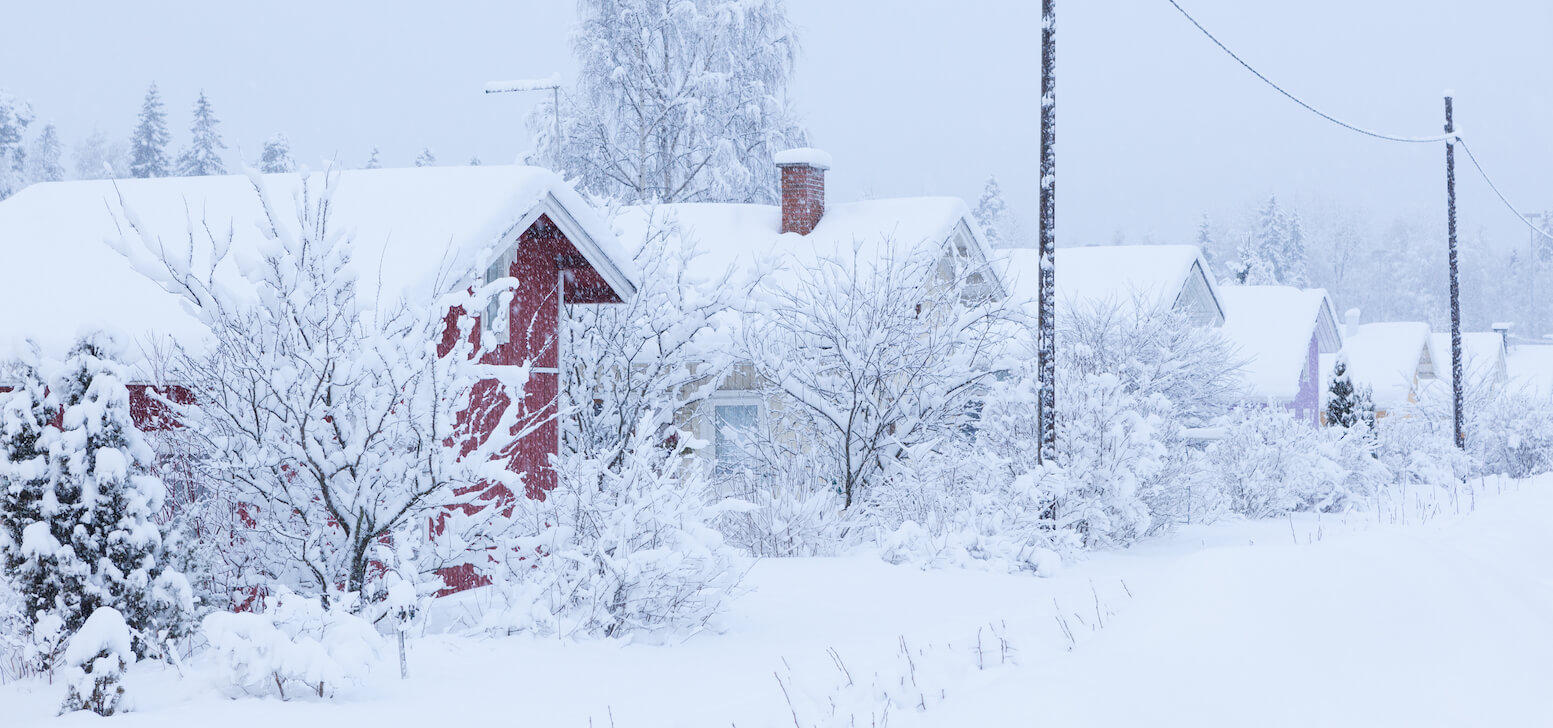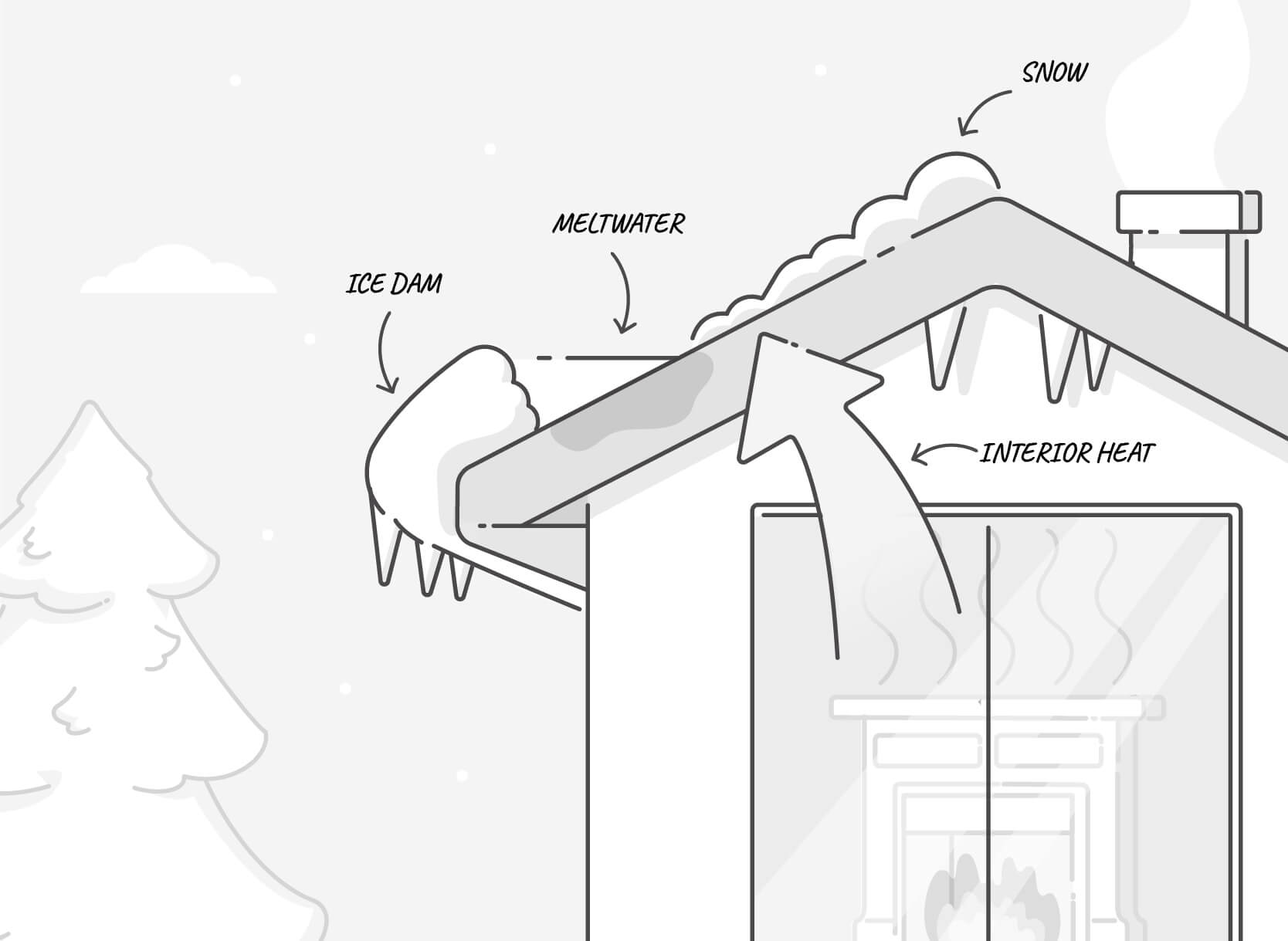Protect Your Home from Severe Winter Storms
Baby, it's cold outside.

Baby, it's cold outside.

There’s nothing like a snowstorm to get you in the spirit of the holiday season. But sometimes, a delicate snowfall turns into a blizzard, which can result in devastating damage to your home. Soon enough, that winter wonderland is a winter disaster.
We’ll go through some of the common damages that can come as a result of a winter storm. Then we’ll unpack whether your homeowners insurance covers those damages, and what you can do to protect your home before the storm rolls in.
Let’s bundle up and get started.
Your pipes are the invisible heroes of your household, making sure you have a steady flow of water in and out of your sinks, showers, hoses, and toilets.
If your pipes freeze, you might be left high and dry. Keep several days worth of water in your home at all times (1 gallon per day, per person,) so you won’t find yourself in a desperate situation.
Some more bad news: If those pipes freeze, you won’t be covered under Loss of Use on your homeowners insurance policy. This means, your policy won’t cover the bill if you end up decamping to a hotel until your water is up and running.
Yes, in this case you’d be covered for both damages to your personal belongings and for Loss of Use (meaning we’d help pay for alternative accommodations while you’re unable to stay in your home).
The difference here is that you have actual physical damages caused by a named peril—in this case, that’s “accidental discharge from a frozen burst pipe”—and so your policy coverage does kick in.
Translation? If your pipes freeze, burst, and damage your home or belongings—you’re covered for both the damages and for temporary accommodations at a hotel or Airbnb. In the event of burst pipes, your homeowners insurance coverage will also cover the costs to access the pipes through the walls.
One caveat here. If you’re taking shelter elsewhere during the winter storm, you’re required to maintain heat in the house, or shut off the water supply, in order to receive coverage for any pipe-related damage you might return to.
If you haven’t lost power and still have heat, there are some tricks you can try to keep your pipes from freezing. Open up any cabinets in the bathroom, kitchen, or laundry room, which will allow warm air to circulate around your plumbing fixtures and possibly prevent pipes from freezing.
You can also leave your faucets running, to prevent frozen pipes from the inside.
It’s not uncommon to lose power during a severe winter storm. With extreme cold right outside your doors, losing power puts your family and your home at risk for some uncomfortable, and even dangerous, conditions.
Power outages, without other physical damage to the building itself, aren’t covered as part of your policy. Such outages are common in the U.S. due to all sorts of bad or inclement weather, and renters and home policies have limited coverage unless there is actual damage to your home.
We have an entire article dedicated to your home and power outages, but we’re happy to give you the TL;DR:
If you’ve ever shoveled a driveway you know that, despite its fluffy appearance, snow is heavy.
If you’re hit with a severe snow storm, your roof can become compromised under the weight of hundreds of pounds of snow, which can lead to leaks if water starts making its way in from above.
Or, the weight of snow or strong winds can take down a tree on your property, causing major damage to your roof, and can cause roof leaks, roof collapse, and water damage which can destroy your stuff.
Or let’s say high-speed blizzard winds roll in and yank a few dozen shingles off, leaving your roof’s foundation (also called decking) and your home vulnerable to the elements.
Luckily, for all of the scenarios above, your homeowners insurance will help reimburse you for damages to your roof, as well as damages to your furniture, appliances, systems, and other stuff that was messed up or destroyed as a result of the water that entered through the storm-created opening in the roof.
By the way, if your roof is approaching or past its expected lifespan (roughly 20 years for most types), it’s more vulnerable to damage and you may have hard time getting or keeping homeowners insurance. It’s never too early to plan for replacing your roof.
Icicles are gorgeous, but also a bit scary. If a bunch of them form off the edges of your roof, this might indicate that you have an ice dam on your hands.
Let’s take a trip back to eighth grade science class. If you have snow packed on your roof, the heat from inside of your house can rise up and melt it. That melted snow can pool and refreeze into a sheet of ice at the edge of your roof, known as an ice dam.
The ice can block your gutters. That means trapped water flowing around up there will have nowhere to go—except, perhaps, down through your roof and into the structure of your home.

Ice dams probably won’t do too much damage to your shingles or roof, but they can cause damage to your walls, ceilings, insulation, and your HVAC and plumbing systems.
Even though ice dams aren’t the immediate or sudden result of snowstorms, damage to the interior of your home caused by ice dams is likely covered by your homeowners insurance policy, but damage to your roof caused by ice dams probably wouldn’t be covered.
When it comes to your roof, take a proactive role in preventing damage this winter. Maintenance is the best defense.
Maintaining your roof means replacing missing shingles regularly, and having your roof inspected around twice a year to spot wear and tear to your vents, skylights, and chimneys. If you feel confident to safely do this yourself, go ahead and grab a ladder and survey the situation both before and after the winter weather season. If you’re not so fond of heights, hire a professional.
Also, don’t forget to maintain and clear your gutters regularly. Clean gutters can be a first line of defense to make sure snow, ice, and debris don’t get trapped on your roof.
To prevent ice dams, you might want to invest in a roof rake, which is a safe and effective (and oddly satisfying) way to remove snow from your roof without hopping on a ladder (please do not climb onto your roof after a snow storm!).
Your building’s code might also require that an ice and water shield is installed along the eaves (the edges that jut out) of your roof.
While replacing all of your home’s windows can indeed improve energy efficiency during the winter, it isn’t cheap.
That said, there are some other more modest tips to follow to fortify your windows for the cold months.
Sure, your homeowners insurance includes personal liability coverage that could kick in if a friend (or the mailman) breaks their leg on your frozen steps. But it’s important to take simple safety precautions to make sure that doesn’t happen in the first place.
Ice melt products are an easy, affordable way for maintaining safety around your home during winter. When applied to walkways, stairs, and driveways, they quickly dissolve ice, preventing slips and falls.
Opt for pet-safe ice melts, which contain non-toxic ingredients, to ensure the well-being of your furry friends while keeping pathways clear.
It’s early spring and you’re enjoying the first warm day of the season. The sun is shining, the birds are chirping, and the winter’s leftover snow is melting into a grey, slushy, freezing mess.
This is called snowmelt flooding, and it can happen when there’s a significant rise in temperature, usually in the late winter or early spring months. Snowmelt flooding can damage your furniture, walls, belongings, and the very structure of your home. It can also leave dangerous mold in its wake.
Damage that comes as the result of melting snow or ice will probably not be covered by homeowners insurance policy, as it falls under an uninsurable peril. You may have the option of tacking on an additional flood insurance policy.
“Uninsured perils” like floods, earthquakes, and mold are common, and apt to cause serious damage that all home insurers can’t provide coverage for in standard home insurance. It’s important to understand the finer points of your coverage so you know exactly what’s covered, and when.
Every insurance policy has certain situations that are excluded from coverage and this is just one of the causes of loss that isn’t covered. BTW this isn’t unique to Lemonade—it’s more or less standard across the industry.
There’s a lot you can do to keep your basement dry and your stuff safe before and after a snowstorm hits.
Before the storm comes…
After the storm comes…
Whether you live in Rochester, New York and get 100 inches of snow a year, or you enjoy the more mild conditions of Raleigh, North Carolina (which averages around 4 inches of the white stuff annually), it pays to be prepared for winter storms.
As we all observed in Texas, extreme winter weather can wreck the most havoc in places that aren’t used to an annual blizzard or two. As climate change increases, it’ll likely become even harder to predict typical weather patterns—leaving the door open for more so-called “freak” meteorological events.
This winter, prepare yourself, stay calm, and get the scoop on how your homeowners insurance coverage can help you weather the storm.
Please note: Lemonade articles and other editorial content are meant for educational purposes only, and should not be relied upon instead of professional legal, insurance or financial advice. The content of these educational articles does not alter the terms, conditions, exclusions, or limitations of policies issued by Lemonade, which differ according to your state of residence. While we regularly review previously published content to ensure it is accurate and up-to-date, there may be instances in which legal conditions or policy details have changed since publication. Any hypothetical examples used in Lemonade editorial content are purely expositional. Hypothetical examples do not alter or bind Lemonade to any application of your insurance policy to the particular facts and circumstances of any actual claim.